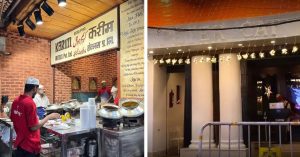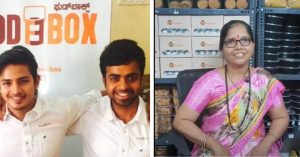India Distributed Food Grains to Over 80.74 Crore People During Lockdown. Here’s How
Despite this number, there is still far to go before we have 100% coverage. Here’s what needs immediate attention.
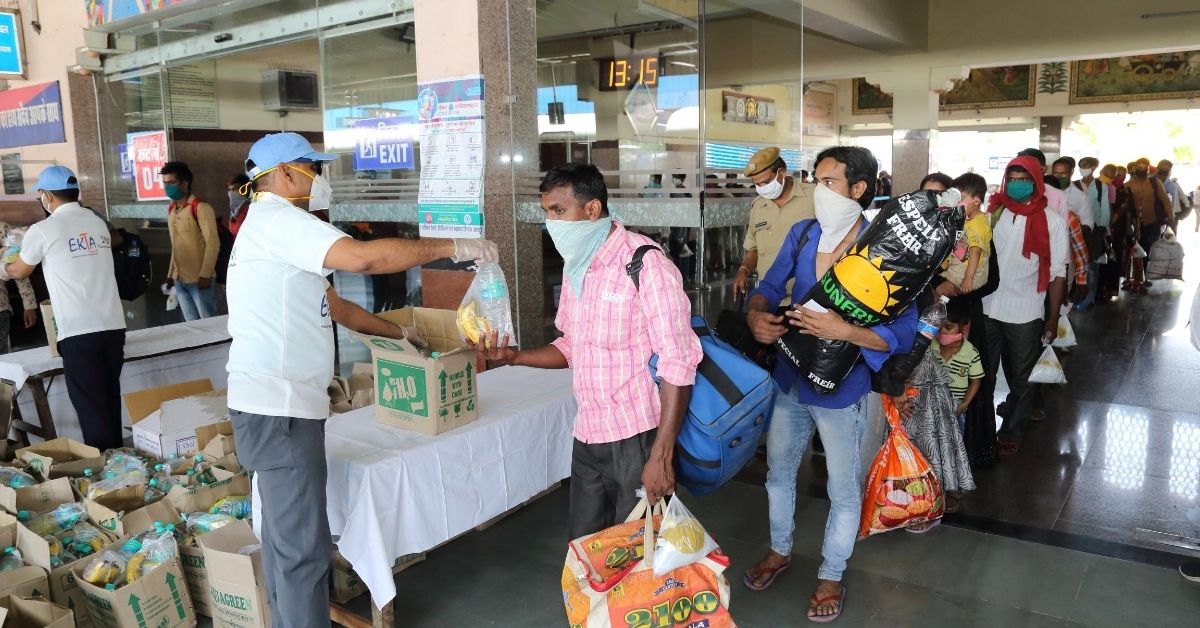
Did you know that India’s Public Distribution System feeds 10 per cent of the world’s population?
The government of India runs 5,37,000 Fair Price Shops. This is the largest food distribution network in the world, spread across 3.3 million sq km serving 80.74 Crore people.
How does this vast and complex system work?
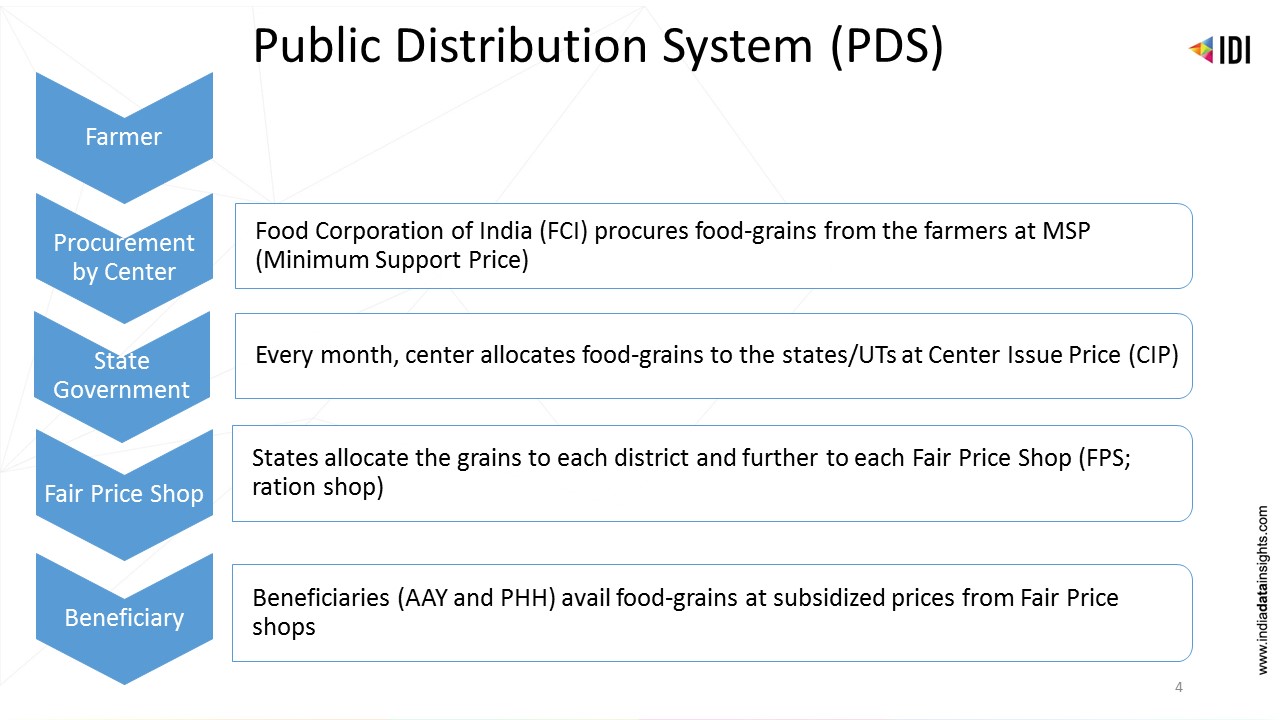
The National Food Security Act (NFSA) came into effect on 5 July 2013. It marked a paradigm shift to food security from welfare to a rights-based approach by legally entitling a large portion of the population to receive subsidised grains.
According to the Act, 75 per cent of rural and 50 per cent of the urban population (overall two-thirds of the total population at the national level) is to be covered by Public Distribution System under two categories:
- AAY (Antyodaya Anna Yojana) – These are the poorest of the low-income families, entitled to 35 kg of food grains per household.
- PHH (Priority Households) – States/UTs determine the families eligible for PHH Ration Cards, who are entitled to 5 kg of food grains per person per month at subsidised prices.
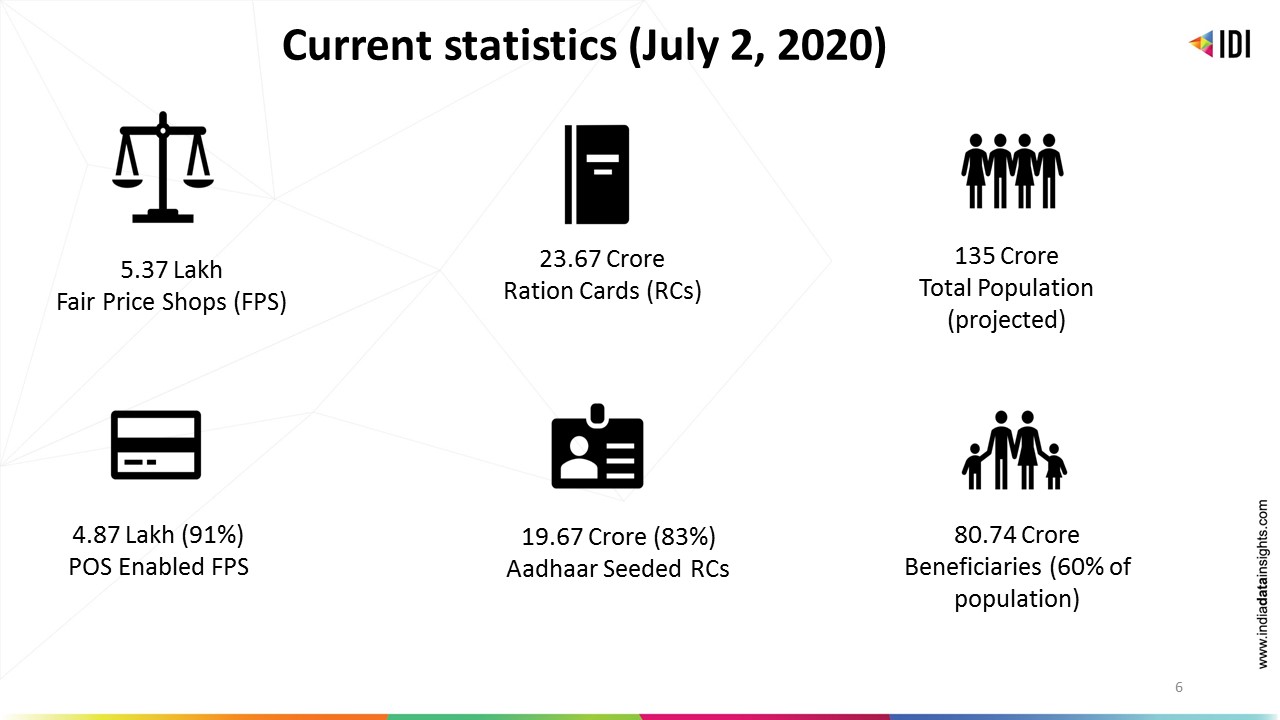
The state-wise coverage of population is determined by the Planning Commission (now NITI Aayog) based on the 2011-12 Household Consumption Expenditure Survey of NSSO. This survey is used to identify the percentage of the population below the poverty line. State targets are set, taking into account the portion of their populations below the poverty line. The actual coverage refers to the number of ration card holders. This is where we stand on target vs actual coverage:
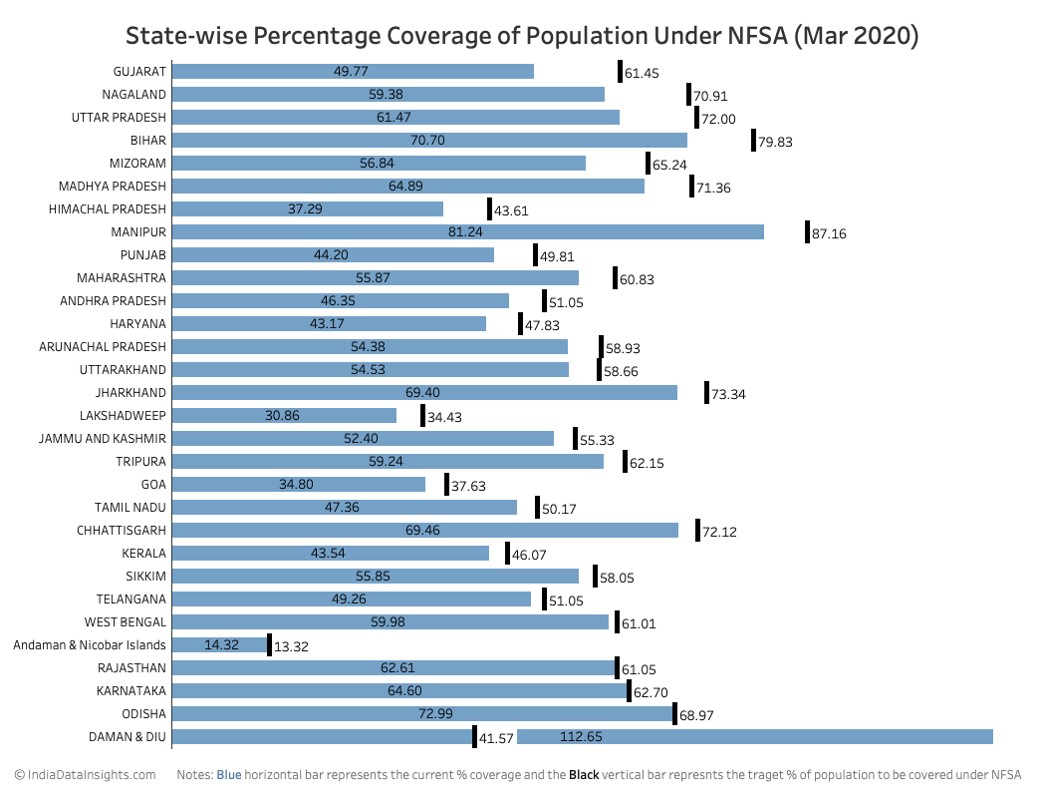
Some of the large states short on their coverage are :
- Gujarat (-11.7%)
- Uttar Pradesh (-10.5%)
- Bihar (-9.1%)
- Madhya Pradesh (-6.5%)
Some lag remains, but we are making progress in the right direction — the number of beneficiaries increased from 56 Crore in 2017 to above 80 Crore in 2020, with eight crore new ration cards issued.
In the same period, the automation of Fair Price Shops increased significantly with over 90 per cent of them equipped with ePoS (Electronic Point of Sale system). Around 93 per cent of the grain distribution is through this system, and the dominant mode of authentication is Aadhaar at 70 per cent.
With better efficiency, transparency and accountability brought in the system by automation, the quantity of food grains distributed per card per month has gone up significantly. In contrast, there has been some rationalisation on the number of beneficiaries per card. Earlier issues of duplicate and bogus cards, obsolete information of card-holders (deceased/newly-born) have been solved to a large extent through the Aadhaar-based authentication.
How did this distribution network perform during the COVID-19 lockdown?
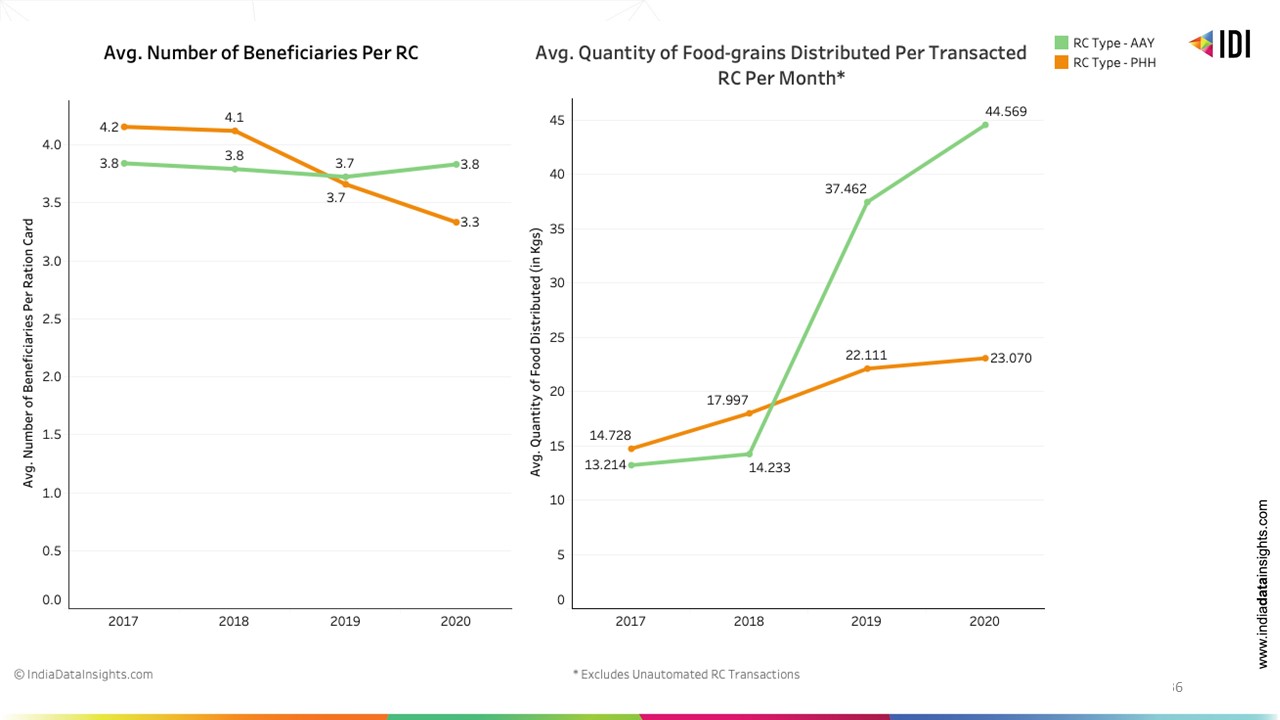
In March ‘20, the Government of India announced additional free food supplies for two-thirds of the population as part of its effort to mitigate the impact of the COVID-19 lockdown. The Pradhan Mantri Garib Kalyan Anna Yojana (PMGKAY) was to support families from April-June using the existing network of Fair Price Shops with the additional provision of 5 kg food-grain plus 1 kg pulses per month.
The latest government data shows that 91 per cent of the quantity allotted by the Centre was procured and lifted by the states, and transported via a record number of railways rakes and trucks. Of the procured quantity, 84 per cent has already reached the intended beneficiaries via the fair price shops.
Most large states managed to distribute over 60 per cent of the allocated food grains, with some exceptions — Punjab, Madhya Pradesh, West Bengal, and Tamil Nadu — lagging. With the scheme being extended to November ’20 as per the recent announcement, there will be time for these states to catch up and fill the distribution gap.
Infrastructure matters.
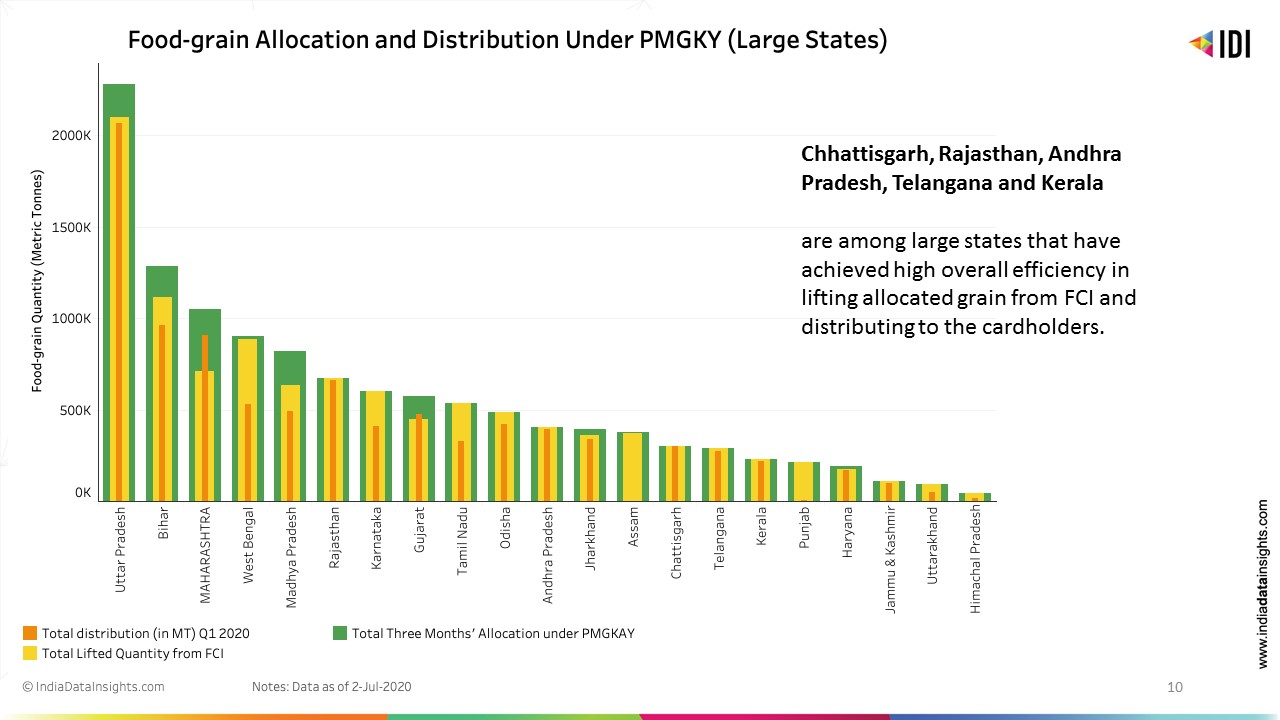
Having an extensive network of Fair Price Shops (there’s a shop per 6 sq km in India) and the digital infrastructure by way of ePos and Aadhaar-based authentication, food grains reached every corner of the country within weeks and were distributed. In the absence of a robust and responsive infrastructure, no quick relief measures could have been implemented.
Even during a long and uncertain COVID-19 lockdown, this infrastructure was silently working to transport the grain to each of those 5.3 lakh shops from Kupwara to Kanyakumari and Kutch to Mon.
In addition to the infrastructure, we have enough stocks in the godowns and enough crops in the fields to provide food security.
What needs immediate attention now is:

- Ration card portability: ‘One Nation One Ration Card’ scheme will enable ration card holders to receive their entitlements from any FPS across the country, irrespective of the state that issued the card. Hardware that’s already put in places such as ePoS, and software updates and digital infrastructure such as Aadhaar authentication are working together to make this possible by March 2021.
- Balanced nutrition: Mere rice and wheat cannot provide enough nutrition — we have a large-scale malnutrition problem that needs to be addressed urgently and holistically. PDS has a role to play by procuring and distributing a wider variety of indigenous and nutritious grains. For instance, Karnataka state has decided to buy and distribute ragi — a welcome step.
- Coverage as planned: Inclusion of all intended beneficiaries is critical and needs to be expedited to ensure that no needy family is left out.
- Operational issues: Infrastructure in the form of ePoS, electricity and internet needed for their working, and reliable ways of authenticating the beneficiaries need to be made robust and fail-proof.
- Empowering FPS owners: The supply chain and transactions are getting automated, leading to better monitoring and efficiency. But last-mile delivery is still in the hands of the Fair Price Shop Owner. Each shop today has about 460 cards associated with it, about 300 of which transact each month.The shop owners make meagre incomes given the wafer-thin margins that the government allows. Some states have experimented with organising retail sales of other products through FPS (like the Annapurna Bhandar Yojana in Rajasthan, now discontinued), but it hasn’t become a robust widespread system.
54 per cent of the shops are owned by individuals, five per cent by Self Help Groups, 15 per cent by co-operative societies and the remaining by Panchayat and others. What kind of training and ongoing support do these shop owners receive? Who is helping them run their businesses better and prosper? Many of the issues highlighted by the media and others — lacking motivation, under-distributing, replacing stocks with inferior goods, and treating customers poorly — can be addressed to some extent by a well-structured training and development programme.
If we fix these issues, we provide lifelong benefits of better daily nutrition to 10 per cent of the world’s population. It’s a problem worth solving!
(Written by Vrunda Bansode and Veda Kulkarni. Edited by Shruti Singhal)
Vrunda Bansode and Veda Kulkarni lead the India Data Insights initiative at Sattva Consulting – a leading social sector research and advisory firm. IDI publishes data-driven analysis on India’s socio-economic issues and policies, to help the organisations working in the social sector make better decisions. Their in-depth analysis on PDS can be accessed here.
This story made me
- 97
- 121
- 89
- 167
Tell Us More
We bring stories straight from the heart of India, to inspire millions and create a wave of impact. Our positive movement is growing bigger everyday, and we would love for you to join it.
Please contribute whatever you can, every little penny helps our team in bringing you more stories that support dreams and spread hope.






